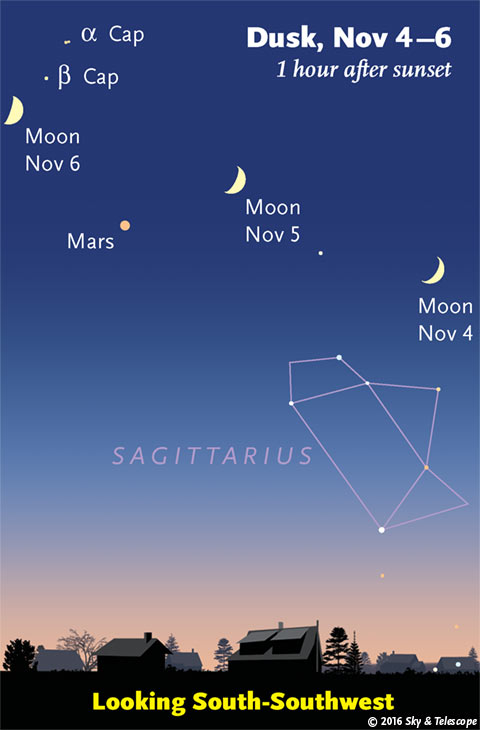
Friday, November 4
• As the stars come out, look off to the Moon's left or upper left for Mars, and high above the Moon for Altair. Deneb still remains near the zenith. Brighter Vega shines high in the west. And look for Arcturus twinkling ever lower toward the west-northwest horizon.
Saturday, November 5
• Mars shines orange to the left or lower of the Moon in early evening, as shown here. Mars is twice the Moon's diameter in reality, but as of tonight, it's 485 times farther away.
• After dark this week Capella calls attention in the northeast, and the Pleiades are well up in the east-northeast three fists to Capella's right. As evening grows later, you'll find orange Aldebaran climbing up below the Pleiades. Then by around 10 p.m. (depending on your location), Orion begins clearing the eastern horizon below Aldebaran.
• Daylight-saving time ends at 2 a.m. Sunday morning; standard time returns. Clocks fall back an hour. Remember when we adjusted them all by hand?
Sunday, November 6
• Now Mars is lower right of the thickening Moon in early evening, as shown above. And look closer to the Moon's upper right for Beta and then Alpha Capricorni. Alpha Cap is a naked-eye double star if you have sharp eyes. Binoculars split it widely — and may reveal Beta as a more difficult, uneven double.
Monday, November 7
• First-quarter Moon (exact at 2:51 p.m. EST). The Moon shines in the south at dusk, just above dim Capricornus. Mars is now far to its lower right. Altair is twice as far to the Moon's upper right.
Tuesday, November 8
• Now the Moon is in Aquarius. Look to the Moon's lower left for Fomalhaut, the Autumn Star, the lonely mouth of Piscis Austrinus the Southern Fish. Half as far above the Moon is the horizontal Water Jar asterism of Aquarius, fairly dim.
• Algol in Perseus shines at its minimum brightness, magnitude 3.4 instead of its usual 2.1, for a couple hours centered on 7:19 p.m. EST.
Wednesday, November 9
• Happy 82nd birthday, Carl Sagan (November 9, 1934 – December 20, 1996). If only.
Thursday, November 10
• Around 8 or 9 p.m., depending on where you live, zero-magnitude Capella rises exactly as high in the northeast as zero-magnitude Vega has sunk in the west-northwest.
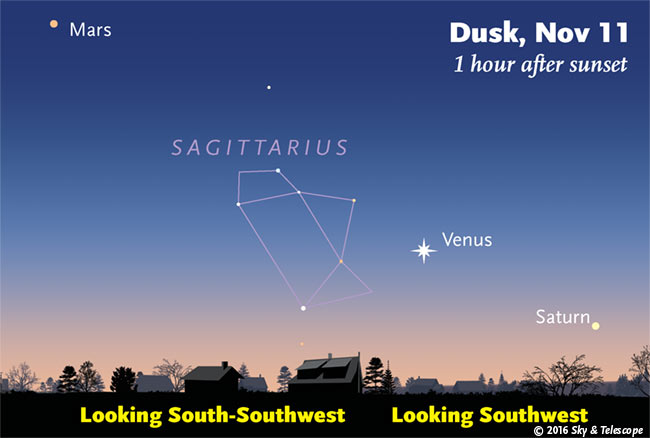
Friday, November 11
• Saturn is falling ever farther away to the lower right of Venus at dusk, while far to the upper left of Venus, Mars is drawing closer to it very, very gradually. The scene above is exact for viewers at 40° north latitude. Far south or north of there, you'll see the view higher or lower and slightly tilted with respect to how it's drawn here.
• By about 8 p.m. now, Orion is clearing the eastern horizon (depending on how far east or west you live in your time zone). High above Orion shines orange Aldebaran. Above Aldebaran is the little Pleiades cluster, the size of your fingertip at arm's length. Far left of the Pleiades shines bright Capella.
Saturday, November 12
• The waxing gibbous Moon shines in the southeast this evening. Upper left of it by about 15° are the two or three leading stars of Aries. About the same distance lower left of the Moon is Menkar, Alpha Ceti, the only brightish star (magnitude 2.5) in Cetus's head.
_________________________
Want to become a better astronomer? Learn your way around the constellations! They're the key to locating everything fainter and deeper to hunt with binoculars or a telescope.
This is an outdoor nature hobby. For an easy-to-use constellation guide covering the whole evening sky, use the big monthly map in the center of each issue of Sky & Telescope, the essential guide to astronomy.
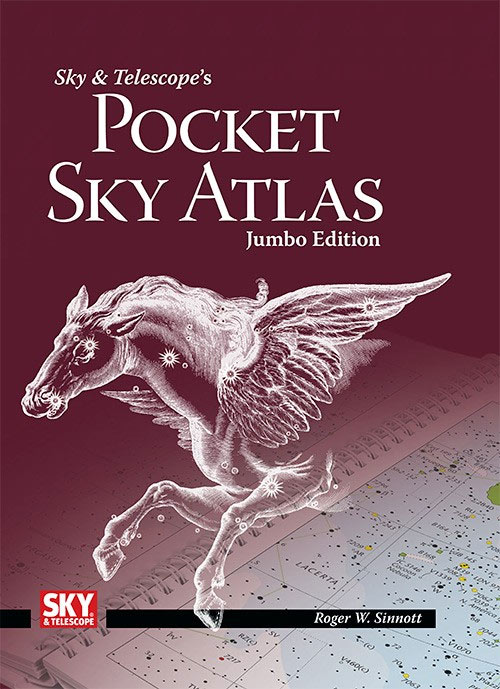
Once you get a telescope, to put it to good use you'll need a detailed, large-scale sky atlas (set of charts). The basic standard is the Pocket Sky Atlas (in either the original or new Jumbo Edition), which shows stars to magnitude 7.6.
Next up is the larger and deeper Sky Atlas 2000.0, plotting stars to magnitude 8.5, nearly three times as many. The next up, once you know your way around, is the even larger Uranometria 2000.0 (stars to magnitude 9.75). And read how to use sky charts with a telescope.
You'll also want a good deep-sky guidebook, such as Sue French's Deep-Sky Wonders collection (which includes its own charts), Sky Atlas 2000.0 Companion by Strong and Sinnott, or the bigger Night Sky Observer's Guide by Kepple and Sanner.
Can a computerized telescope replace charts? Not for beginners, I don't think, and not on mounts and tripods that are less than top-quality mechanically (meaning heavy and expensive). And as Terence Dickinson and Alan Dyer say in their Backyard Astronomer's Guide, "A full appreciation of the universe cannot come without developing the skills to find things in the sky and understanding how the sky works. This knowledge comes only by spending time under the stars with star maps in hand."
This Week's Planet Roundup
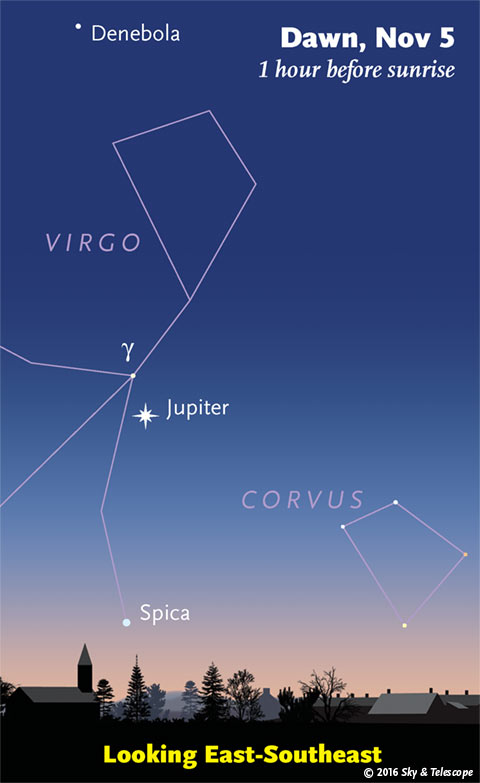
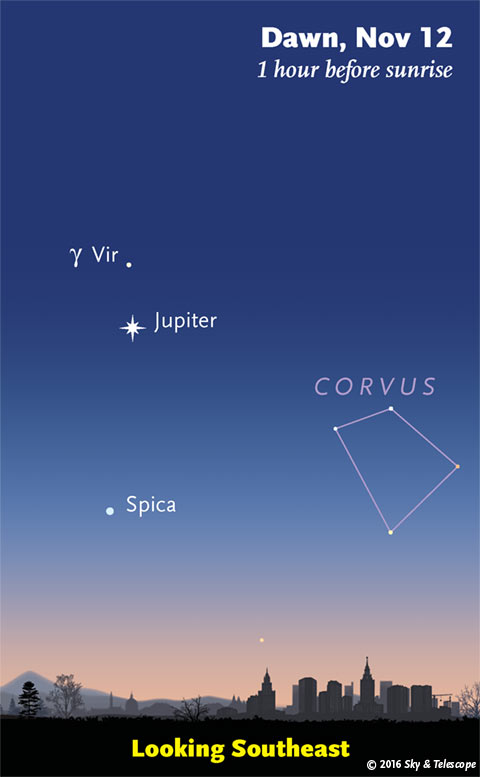
Mercury is hidden in the glare of the Sun.
Venus (magnitude –4.0) shines brightly in the southwest during evening twilight. It's now setting a good half hour after the end of twilight.
Mars (magnitude +0.4) still glows in the south-southwest at dusk, about 35° upper left of Venus. In a telescope, Mars has shrunk to a mere 7 arcseconds in diameter.
Jupiter (magnitude –1.7) shines brightly in the east-southeast in early dawn. Look for Spica about 12° below it.
You might think this is a very poor time for seeking detail on Jupiter with a telescope. It's not only low but distant and small, a mere 32 arcseconds wide. But amateurs who are imaging Jupiter at every opportunity in support of NASA's Juno mission report that a predicted outbreak of storms in the North Temperate Belt has begun. See Jupiter Returns with a Stormy Surprise. Best viewing: early dawn, and continue watching until the sky grows too bright.
Saturn (magnitude +0.5) glimmers low in the southwest, to the right or lower right of Venus as twilight fades. It's 7° from Venus on November 4th and 11° from it a week later.
Uranus (magnitude 5.7, in Pisces) and Neptune (magnitude 7.9, in Aquarius) are high in the southeast and south, respectively, in early evening. Info and finder charts.
__________________________
All descriptions that relate to your horizon — including the words up, down, right, and left — are written for the world's mid-northern latitudes. Descriptions that also depend on longitude (mainly Moon positions) are for North America.
Eastern Daylight Time (EDT) is Universal Time (UT, UTC, or GMT) minus 4 hours. Eastern Standard Time (EST) is UT minus 5 hours.
__________________________
"This adventure is made possible by generations of searchers strictly adhering to a simple set of rules. Test ideas by experiments and observations. Build on those ideas that pass the test. Reject the ones that fail. Follow the evidence wherever it leads, and question everything. Accept these terms, and the cosmos is yours."
— Neil deGrasse Tyson
 0
0








Comments
You must be logged in to post a comment.